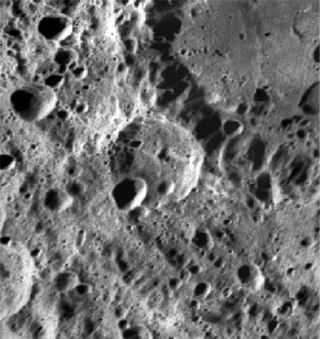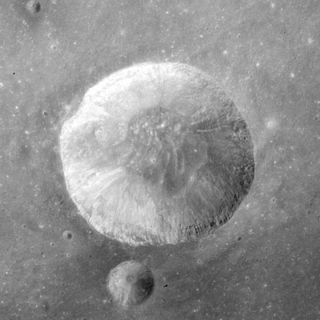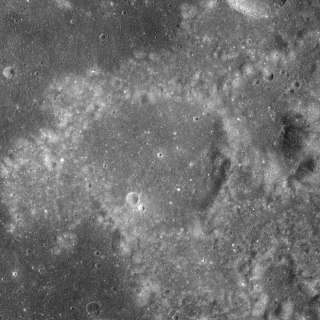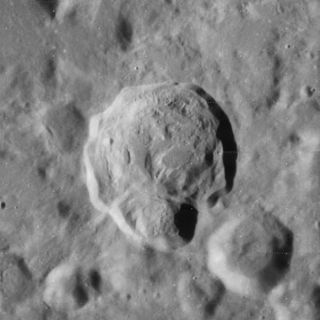
Beaumont is a lava-flooded crater located on the southwestern shore of the Mare Nectaris on Earth's Moon. It lies to the northwest of the similarly flooded crater remnant Fracastorius. To the west is the prominent crater Catharina. The crater is named after French geologist Léonce Élie de Beaumont.

Deseilligny is a small lunar impact crater in the southern part of the Mare Serenitatis. It was named after French selenographer Jules Deseilligny. It is located to the east-southeast of the crater Bessel. Deseilligny is a bowl-shaped crater with a low rim. It is otherwise undistinguished.

Beketov is a small lunar impact crater that lies in the northern reaches of the Mare Tranquillitatis. It is named after Russian chemist Nikolay Beketov. To the south is the ghost crater Jansen R. Northeast of Beketov, along the edge of the mare, is the crater Vitruvius. Beketov was previously designated Jansen C before being named by the IAU. The flooded crater Jansen itself lies to the south.

Bombelli is a small lunar impact crater that is located in the highlands to the north of the Sinus Successus. It was named after Italian mathematician Raphael Bombelli. It was previously designated Apollonius T. The crater Apollonius is located to the east-southeast.

Bowen is a small lunar impact crater that is located to the southwest of the Montes Haemus, on the edge of a small lunar mare named the Lacus Doloris. It was named after American astronomer Ira S. Bowen. It is distinguished only by having a relatively flat floor, rather than being bowl-shaped like most small craters. Bowen was previously designated Manilius A. The crater Manilius is located to the south, at the opposite shore of the Lacus.

Cartan is a small lunar impact crater near the eastern edge of the Moon. It lies just to the west of the larger Apollonius. The rim is circular with a tiny crater along the eastern side. The interior floor is about half the diameter of the crater. A smaller crater attached to the southern rim is also attached to the north rim of Apollonius H, forming a short crater chain.

Crile is a tiny lunar impact crater. It is roughly circular and cup-shaped, with interior walls that slope down to the midpoint. The crater lies in the Palus Somni, between the Mare Crisium to the east and Mare Tranquillitatis to the west.

Proclus is a young lunar impact crater located to the west of the Mare Crisium, on the east shore of the Palus Somni. Its diameter is 27 km. It was named after 5th century Greek mathematician, astronomer and philosopher Proclus.

Belyaev is a lunar impact crater that is attached to the outer edge of the Mare Moscoviense, on the far side of the Moon. It is a worn formation with a small crater pair overlaying the southern rim, and several smaller craters across the relatively irregular interior.

Carmichael is a lunar impact crater that is located along the eastern edge of the Sinus Amoris, in the northeastern quadrant of the Moon's near side. Its diameter is 20 km. It was named after American psychologist Leonard Carmichael. It lies within a couple of crater diameters south-southwest of the smaller crater Hill. Further to the east-northeast is the prominent crater Macrobius. Carmichael was designated Macrobius A before being given its current name by the IAU.

Peirce is a small lunar impact crater in the western part of Mare Crisium. That dark, circular lunar mare is located in the east-northeasterly part of the Moon's near side. It was named after the American mathematician Benjamin Peirce. Peirce lies to the north of the craters Yerkes and Picard, and southeast of Macrobius located outside the mare. Just over a crater diameter to the north of Peirce is the smaller Swift. To the northwest is the wrinkle ridge Dorsum Oppel.

Esclangon is a lunar impact crater that is located in the rugged terrain to the northwest of the prominent crater Macrobius, and east of Sinus Amoris. Its diameter is 15 km. It was named after French astronomer Ernest Esclangon. This formation was previously designated Macrobius L. Just to the west-southwest is the crater Hill. Lacus Bonitatis, the Lake of Good, is located to the east and northeast of Esclangon.

Elmer is a small lunar impact crater that is located to the south of Mare Smythii, near the eastern limb of the Moon. This crater is seen at a highly oblique angle from Earth, and the visibility is affected by libration. Elmer lies southwest of the crater Kreiken, and east-southeast of the larger Dale. This is a circular, bowl-shaped crater with an interior floor that occupies about half the total diameter.

Hill is a small lunar impact crater that is located to the west of the prominent crater Macrobius, near the eastern edge of the Sinus Amoris. Its diameter is 16 km. It was named after American astronomer George William Hill. It was previously designated Macrobius B. It lies just to the north-northeast of Carmichael, another renamed satellite crater of Macrobius.

Macrobius is a prominent lunar impact crater located to the northwest of the Mare Crisium. Its diameter is 63 km. It was named after ancient Roman writer Macrobius. It lies on the southeast edge of the Lacus Bonitatis, a small lunar mare. The somewhat smaller crater Tisserand lies just to the east.

File: Franz is a small lunar impact crater identified during the Apollo mission in August 1971 and located along the eastern edge of the Sinus Amoris, a bay that forms a northern extension to the Mare Tranquillitatis. Its diameter is 25 km. It was named after German astronomer Julius Heinrich Franz. It lies to the southwest of the prominent crater Macrobius. To the north is the smaller Carmichael, and to the northwest is the diminutive Theophrastus.

Newcomb is a lunar impact crater that is located in the rugged Montes Taurus mountain range, to the east of the Mare Serenitatis. It lies to the northeast of the prominent crater Römer, and north-northwest of Macrobius.

Tisserand is a lunar impact crater that is located just to the east of the larger crater Macrobius, to the northwest of the Mare Crisium. The crater was named after French astronomer François Félix Tisserand in 1935.

Chang Heng is a lunar impact crater that is located on the Moon's far side. It lies less than one crater diameter to the northeast of the walled plain Fleming. The rim of this crater is somewhat eroded, with a pair of small craters along the northern rim and tiny craters along the south and east edges. The interior floor contains a small, concentric crater that is about one third the diameter of Chang Heng. The crater is named after Chinese astronomer Zhang Heng.

Diderot is a small lunar impact crater on the far side of the Moon. It lies within the southwestern interior floor of the huge walled plain Fermi, about midway between the basin midpoint and the southwest rim. The crater is saucer-shaped, with smaller craters located just to the northwest and the north. The inner wall is narrower along the eastern side, and has a pair of ridges along the southern face. This crater is otherwise unremarkable.





















